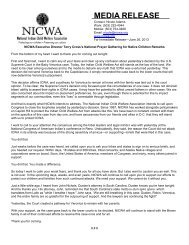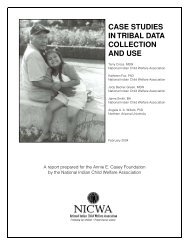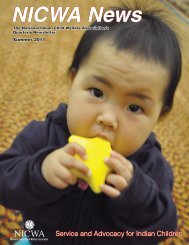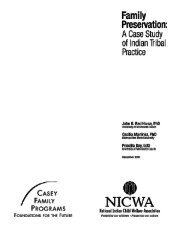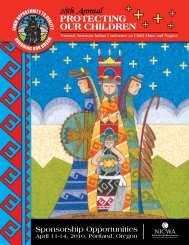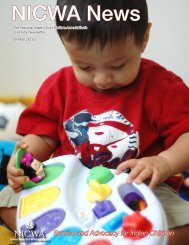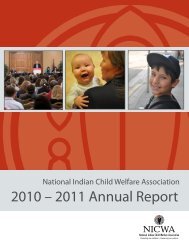Native American Children and Youth Well-Being Indicators
Native American Children and Youth Well-Being Indicators
Native American Children and Youth Well-Being Indicators
Create successful ePaper yourself
Turn your PDF publications into a flip-book with our unique Google optimized e-Paper software.
RecommendationsResearchResearch studies provide the empirically-basedevidence for policymakers to design, modify,eliminate, <strong>and</strong>/or change policies. The resultsof research projects provide health <strong>and</strong> humanservices policymakers with data to make policies<strong>and</strong>/or programs more efficient, timely, costeffective,<strong>and</strong> culturally relevant. Historically,research has mainly benefited researchers <strong>and</strong>not the community itself. <strong>Native</strong> <strong>American</strong>s arechanging this pattern by conducting researchthemselves in their own tribal communities withdirect benefits to their tribes <strong>and</strong> communities.NICWA, in cooperation with Casey FamilyPrograms, is changing this pattern to benefittribes in their own environments as demonstratedby the publication of two previous reports(Goodluck & Willeto, 2000, 2001).While there are several research methodologiesto select from, this study utilized the qualitativemethod to organize the study. The professionalliterature is only one avenue to ascertain examplesof <strong>Native</strong> <strong>American</strong> strengths forchildren <strong>and</strong> youth. The most relevant sourceof information is the people themselves in theirown natural environments. To help improve theconduct of research with tribal communities,future research-oriented projects could includethe following:• Seek out other sources of data presented inother narrative formats such as songs, shortstories, novels, poetry, <strong>and</strong> oral histories thatcan be evaluated for examples of <strong>Native</strong><strong>American</strong> strengths.• Develop consistent definitions of termssuch as “strengths” <strong>and</strong> “well-being” that areaccepted by many tribal entities in order toensure consistent future research.• Assist tribes in designing their own researchstudies <strong>and</strong> increase the validity of thesestudies by utilizing quantitative researchmethods in addition to qualitative methods.• Considering that there are 558 tribal entitiesin the United States, it is not practical to haveevery tribe conduct research on its ownstrengths. Therefore, it is suggested thatthree to five tribes take the lead on researchingthis topic.• Facilitate tribal efforts to design <strong>and</strong> implementtribal focus groups to discuss the findingspresented in this study <strong>and</strong> to comparetheir own tribal strengths with the conceptsaddressed here.• Discuss the model proposed in this studywith tribes to determine if they are appropriate<strong>and</strong>/or applicable to that specific tribe. Some43




